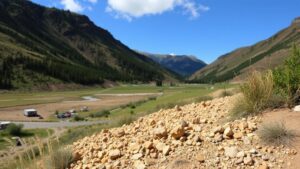Processing Sediments From Seasonal Streams in Desert Regions for Gold
Processing Sediments From Seasonal Streams in Desert Regions for Gold
Desert regions, often characterized by their arid climates and limited vegetation, are surprisingly rich in mineral resources, including gold. Seasonal streams in these areas can become channels for gold deposition due to their unique hydrological patterns. This article will explore the processes involved in extracting gold from these sediments, the methods utilized, and the challenges faced in such environments.
The Geology of Gold Deposits in Desert Streams
Gold is primarily found in its native state and is often formed through hydrothermal processes. In desert areas, seasonal streams can transport gold particles from their source rocks, typically found in higher elevation regions. Erosion and weathering processes break down these rocks, allowing gold to be transported downstream.
Plus, the physical characteristics of desert streams, such as their intermittent flow, lead to the concentration of gold particles in specific areas. Understanding the geology and hydrology of these streams is crucial for effective gold prospecting.
Methods of Processing Stream Sediments for Gold
Several techniques can be employed to extract gold from sediments found in seasonal streams. most common methods include:
- Panning: This traditional method involves using a shallow pan to wash sediment, allowing heavier gold particles to settle at the bottom.
- sluicing: Sluices are long, trough-like structures that utilize gravity and water flow to separate heavier materials from lighter ones, effectively concentrating gold sand.
- Highbanking: This method combines aspects of both panning and sluicing, where sediment is dug from the streambed and processed in a highbanker setup positioned above the water source.
- Dry Washing: In areas where water is scarce, dry washing utilizes air instead of water to separate gold from lighter sediments.
Challenges of Gold Processing in Desert Environments
Processing gold from seasonal streams in desert regions presents unique challenges that must be addressed for successful extraction. These include:
- Water Scarcity: Limited water availability is a significant obstacle. Gold processing often requires large volumes of water, making it difficult to implement efficient methods such as sluicing.
- Extreme Weather Conditions: Desert climates are notorious for their temperature fluctuations, which can affect the efficiency of processing equipment and worker safety.
- Environmental Regulations: Desert ecosystems are delicate, and mining activities must comply with strict environmental regulations to prevent degradation of the fragile habitat.
Real-World Applications and Case Studies
Numerous mining companies and independent prospectors have successfully harnessed the potential of seasonal streams in desert regions. For example, in the Mojave Desert, California, small-scale miners have utilized dry washing techniques to extract gold during periods of drought, showcasing adaptability in mining practices.
Plus, technological advancements have allowed for more efficient processing methods. The implementation of portable GPS and geological mapping tools helps identify promising areas, thereby improving the yield of gold extraction efforts.
Conclusion and Actionable Takeaways
In summary, the processing of sediments from seasonal streams in desert regions for gold extraction is a multifaceted endeavor influenced by geological, hydrological, and environmental factors. Miners must adopt specific techniques such as panning, sluicing, and dry washing while navigating the unique challenges of water scarcity and environmental protection.
For those interested in pursuing gold recovery in these areas, it is crucial to:
- Conduct thorough geological surveys to identify potential gold-rich stream beds.
- Stay informed about local regulations governing mining activities in desert environments.
- Use innovative techniques and tools to improve efficiency and minimize environmental impact.
By understanding the processes involved and employing effective strategies, individuals and mining operations can successfully explore the gold-mining potential of seasonal streams in desert regions.


